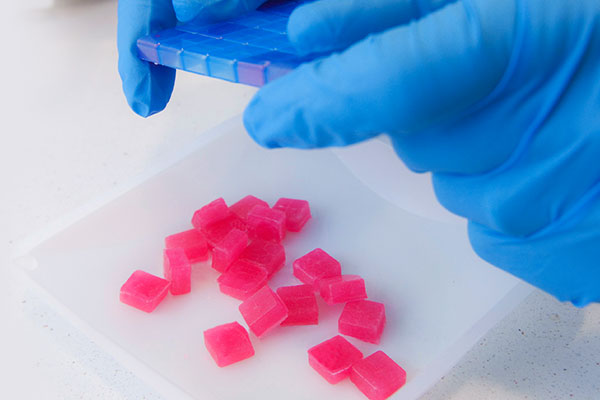What Is Troche Medication Used For?

typically between the cheek and gum or under the tongue. Troches are often used for a variety of therapeutic purposes, particularly when a fast-acting medication is needed or when a patient has difficulty swallowing traditional pills or capsules. This article will explore the uses, benefits, and considerations of troche medications, including their role in treating various medical conditions.
What is a Troche?
A troche, sometimes also called a lozenge, is a small, disc-shaped or flat medication that dissolves in the mouth. Unlike typical tablets or capsules, which are ingested whole and processed in the digestive system, troches are designed to be absorbed directly through the mucous membranes in the mouth. This can provide a quicker onset of action, as the medication bypasses the gastrointestinal tract and enters the bloodstream more rapidly.
Troches may contain a variety of active pharmaceutical ingredients, and they are commonly formulated with sweeteners, flavorings, and a base that allows them to dissolve smoothly. They can be made in a wide range of doses depending on the specific medication they contain.
How Troche Medication Works
Troche medications are often designed for absorption through the buccal or sublingual mucosa, which means the lining of the mouth. These areas have a rich supply of blood vessels that can quickly absorb substances and transport them into the bloodstream. This unique method of drug delivery offers several advantages, such as faster absorption and fewer digestive side effects.
For medications that are absorbed under the tongue (sublingual), the active ingredient enters the bloodstream almost immediately. For medications that are absorbed in the cheek area (buccal), absorption may take a bit longer but still happens faster than with oral tablets or capsules.
Because the medication bypasses the stomach and intestines, it can be particularly useful for people who have trouble with gastrointestinal absorption, suffer from nausea or vomiting, or experience slow digestion. It also helps avoid the “first-pass effect,” which occurs when medications are metabolized in the liver before they reach the bloodstream, reducing the drug’s potency.
Common Uses of Troche Medication
Troche medications are often used in conditions that require localized treatment in the mouth, throat, or mucosal membranes, but they can also be effective for treating systemic conditions that benefit from rapid absorption. Some of the most common uses include:
1. Hormonal Therapy
One of the most common uses for troche medications is in hormone replacement therapy (HRT). Troches can be used to deliver bioidentical hormones such as estrogen, progesterone, and testosterone. For example, women going through menopause may use a troche containing estrogen to help manage symptoms such as hot flashes, night sweats, and mood swings. Troches offer a convenient and effective way to deliver hormones into the bloodstream quickly, particularly for individuals who might have difficulty swallowing pills or who prefer a non-invasive option.
Testosterone troches are also sometimes used for hormone therapy in men, especially in the treatment of low testosterone levels. These troches can help restore energy levels, improve libido, and support muscle mass, among other benefits. Some patients prefer using a troche because it avoids the need for injections or creams.
2. Treatment of Oral Thrush and Other Oral Infections
Troche medications are frequently used in the treatment of oral thrush, a fungal infection caused by an overgrowth of Candida in the mouth. Antifungal troches, such as those containing clotrimazole or nystatin, are commonly prescribed for this condition. The medication is dissolved slowly in the mouth, allowing the antifungal properties to target the affected areas directly. This localized treatment is often more effective and convenient for patients with oral infections compared to other systemic treatments.
Troches can also be used to treat other oral infections or conditions, such as dry mouth (xerostomia) and certain types of gum disease, where direct application to the affected areas can provide faster relief.
3. Pain Management and Analgesia
Troche medications are sometimes used for pain management, particularly for conditions that cause chronic or acute pain in the mouth, throat, or other areas of the mucous membranes. Certain formulations of troches may contain analgesic or numbing agents like lidocaine or benzocaine. These medications help to numb the area and provide temporary relief from pain or discomfort.
For example, troches with lidocaine are used for conditions like sore throats, canker sores, or post-surgical pain following dental or oral procedures. The rapid dissolution and direct absorption of the active ingredients can provide faster and more effective pain relief compared to oral tablets.
4. Treatment of Nausea and Vomiting
Another common use for troche medications is in the management of nausea and vomiting, particularly for patients undergoing chemotherapy or those who suffer from motion sickness. Troches containing antiemetic drugs such as ondansetron or scopolamine can be an effective solution when patients are unable to keep down oral medications.
For chemotherapy patients, the ability to use a troche to dissolve medication in the mouth can provide more rapid relief from nausea and vomiting. This method of administration can also help prevent the patient from vomiting up the medication before it has time to take effect.
5. Anxiety and Stress Management
Troche medications may be used for managing anxiety and stress, particularly when rapid relief is needed. Medications like lorazepam or diazepam (commonly known as Ativan and Valium, respectively) may be formulated into troche forms. These medications are anxiolytics, which help to reduce anxiety and promote relaxation by affecting the brain’s neurotransmitters. The advantage of using a troche is the speed at which these medications are absorbed, which can provide relief in stressful situations or acute anxiety episodes.
Patients who suffer from panic attacks or severe anxiety can find troches helpful, as they allow the drug to take effect more quickly than if it were taken as a pill.
6. Sublingual Delivery of Vitamins and Supplements
While less common, some troche medications are used for vitamin and supplement delivery, particularly for individuals who have difficulty swallowing pills. Troches containing vitamin B12, for example, are sometimes prescribed for patients with B12 deficiencies or those who have trouble absorbing the vitamin through the digestive system. The sublingual or buccal absorption of these vitamins ensures that the nutrients are absorbed quickly into the bloodstream, bypassing the digestive tract entirely.
In addition to vitamin B12, other supplements such as vitamin D and magnesium may also be available in troche form for specific medical conditions or nutritional support.
7. Smoking Cessation and Nicotine Replacement
Troches are sometimes used as a form of nicotine replacement therapy for those who are trying to quit smoking. Nicotine-containing troches work by delivering a controlled amount of nicotine through the mucous membranes in the mouth. This can help reduce withdrawal symptoms and cravings by maintaining a steady level of nicotine in the bloodstream without the harmful effects of smoking.
The use of nicotine troches is part of a broader approach to smoking cessation, which may also include patches, gum, or prescription medications.
Benefits of Troche Medications
There are several advantages to using troche medications, including:
- Faster Absorption: Since troches are absorbed directly through the mouth’s mucous membranes, they often provide faster relief compared to traditional oral medications.
- Ease of Use: For individuals who have difficulty swallowing pills or capsules, troches can be an excellent alternative. They dissolve easily in the mouth and don’t require water to swallow.
- Bypass Digestive Issues: Troches bypass the digestive system, which can be beneficial for individuals with gastrointestinal problems such as acid reflux, ulcers, or those who suffer from nausea or vomiting.
- Local Effect: Many troches are designed to provide a localized effect, directly targeting the affected area in the mouth or throat. This makes them ideal for conditions such as oral infections or sore throats.
Considerations and Side Effects
Like all medications, troches come with certain considerations and potential side effects:
- Mouth Irritation: Some individuals may experience irritation or dryness in the mouth after using troche medications. This is particularly true if the medication contains alcohol or other chemicals that can be drying.
- Taste: Troches can sometimes have a strong or unpleasant taste, which may be a downside for some users. However, many troches are flavored to improve the experience.
- Dosage Concerns: Troches are formulated for slow absorption, and the total dosage absorbed may be influenced by how long the troche is kept in the mouth. It is important to follow the prescribed instructions to ensure the correct amount of medication is absorbed.
- Allergic Reactions: As with any medication, some individuals may experience allergic reactions to the active ingredients in troches. It is important to consult with a healthcare provider if you have known allergies to certain medications or components.
Conclusion
Troche medications are an effective and versatile treatment option for many medical conditions, particularly when a fast-acting medication is needed or when a patient has difficulty swallowing pills. Whether used for hormone therapy, pain management, or managing conditions like oral thrush or anxiety, troches offer a convenient alternative to traditional oral medications. However, like any medication, they should be used under the guidance of a healthcare provider to ensure the best possible outcomes. The ability of troches to deliver medication quickly and efficiently makes them a valuable tool in modern medicine.





